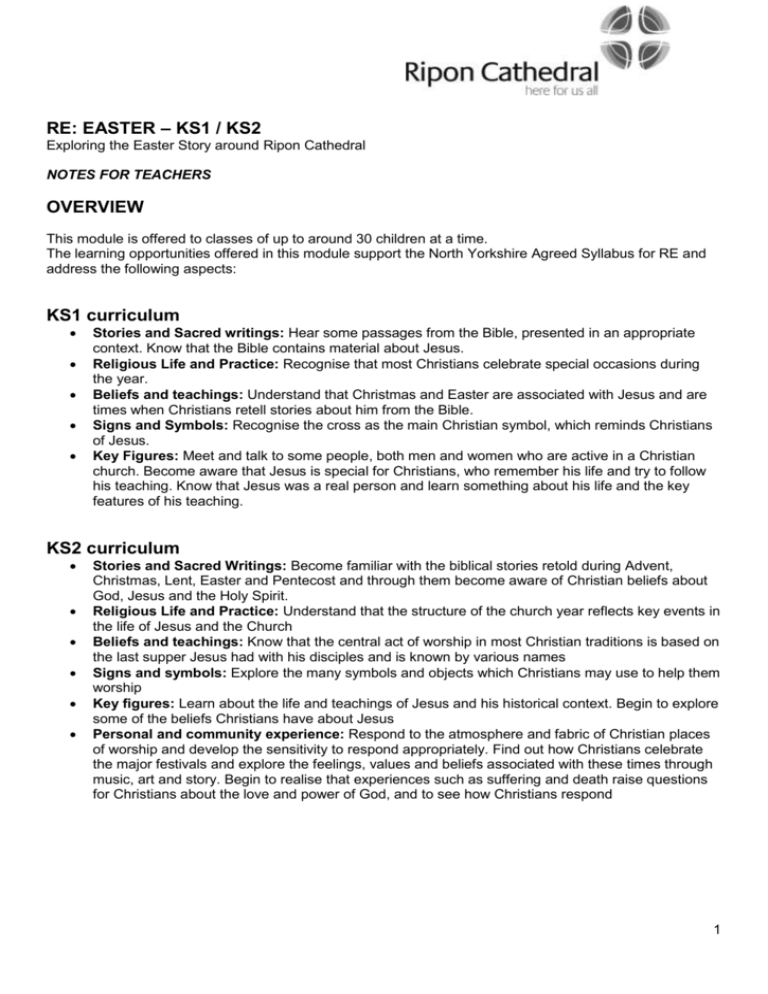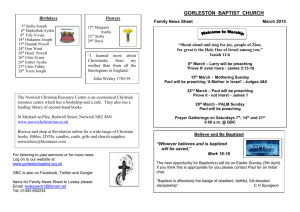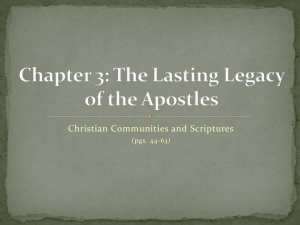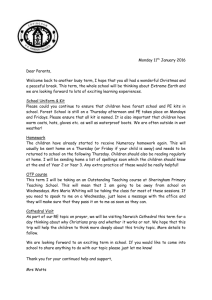RE_KS1_EASTER_TEACHERSNOTES
advertisement

RE: EASTER – KS1 / KS2 Exploring the Easter Story around Ripon Cathedral NOTES FOR TEACHERS OVERVIEW This module is offered to classes of up to around 30 children at a time. The learning opportunities offered in this module support the North Yorkshire Agreed Syllabus for RE and address the following aspects: KS1 curriculum Stories and Sacred writings: Hear some passages from the Bible, presented in an appropriate context. Know that the Bible contains material about Jesus. Religious Life and Practice: Recognise that most Christians celebrate special occasions during the year. Beliefs and teachings: Understand that Christmas and Easter are associated with Jesus and are times when Christians retell stories about him from the Bible. Signs and Symbols: Recognise the cross as the main Christian symbol, which reminds Christians of Jesus. Key Figures: Meet and talk to some people, both men and women who are active in a Christian church. Become aware that Jesus is special for Christians, who remember his life and try to follow his teaching. Know that Jesus was a real person and learn something about his life and the key features of his teaching. KS2 curriculum Stories and Sacred Writings: Become familiar with the biblical stories retold during Advent, Christmas, Lent, Easter and Pentecost and through them become aware of Christian beliefs about God, Jesus and the Holy Spirit. Religious Life and Practice: Understand that the structure of the church year reflects key events in the life of Jesus and the Church Beliefs and teachings: Know that the central act of worship in most Christian traditions is based on the last supper Jesus had with his disciples and is known by various names Signs and symbols: Explore the many symbols and objects which Christians may use to help them worship Key figures: Learn about the life and teachings of Jesus and his historical context. Begin to explore some of the beliefs Christians have about Jesus Personal and community experience: Respond to the atmosphere and fabric of Christian places of worship and develop the sensitivity to respond appropriately. Find out how Christians celebrate the major festivals and explore the feelings, values and beliefs associated with these times through music, art and story. Begin to realise that experiences such as suffering and death raise questions for Christians about the love and power of God, and to see how Christians respond 1 THE VISIT Prior to the visit We ask that schools make palm crosses before they come (using approximately A4 sized green paper). These will be used at the start of the day and incorporated into group art in the afternoon session. The module is led by members of the Ripon Cathedral Education Team. The morning session (9.30am – 12noon) During the session, the children will be taken around the Cathedral building, pausing en route to experience a series of activities. These four inputs will explain the events of Palm Sunday, Maundy Thursday, Good Friday and Easter Day. Links will be made between the Biblical story of Easter and Christian celebrations, practices and symbols. A pause for refreshments and for the children to be taken to the toilets (in small groups) is timetabled after the first hour. The morning is structured so that children are not being asked to sit and listen for more than 15 minutes at a time. We will move around the building at regular intervals and children will have chance to get a sense of the scale of the building and spend time in a variety of spaces within the Cathedral. By the end of the morning session, children should be able to sequence the four days we have explored. Lunch Children can eat packed lunches at Thorpe Prebend House, adjacent to the Cathedral. After eating their lunch, they are invited (in supervised groups) to explore the History of Ripon interpretation centre upstairs at Thorpe Prebend. This activity is optional and is not related to the Easter module, but explores aspects of local history with a number of interactive elements, touching on Wilfred Owen, Alice in Wonderland and the history of the Cathedral. There is a playground close to Thorpe Prebend should some running around time outdoors be required. Please note that this will require risk assessment taking into account the River Skell on the far edge of the playground. The afternoon session (typically 1pm – 2.30pm) Four activities will be available to reinforce the scenes explored during the morning session. These will involve making a tableau for three of the four days (a mixture of individual and whole group work). These can be taken back to school at the end of the session. Cost: Morning session only - a donation of £1 per child Whole day – a donation of £2 per child, plus £25 for the use of the Cathedral Hall. 2 More detailed running order for the day Morning exploration and learning 9.30am Met at West Doors by a member of the Education Team, welcomed into the Cathedral. Introduction to the morning: learning the Easter story by exploring the building. 9.40am Palm Sunday Waving our palm leaves, we process all around the Cathedral, pausing to listen to another part of the story as we go. 9.50am Maundy Thursday – The Last Supper In the St Wilfrid Chapel, we sit around the edges of a sheet spread out as if for the last supper. The story of the events of that meal are retold in a child-friendly way. As it is retold, it is re-enacted with children playing various roles and passing bread and wine (blackcurrant juice!) around the group so they can feel, see and smell it. After the story has finished, we move to the Mothers’ Union chapel next door where a table is set for a Communion service. The link between the Last Supper and the Christian service of Holy Communion (Eucharist) is explained. 10.10am Good Friday – The Crucifixion We walk around the Cathedral until we come to the font. The events of Good Friday are retold in a child-friendly account. The cross is explained as a symbol of God’s forgiveness. Children are given Post-it notes and invited to remember something they have done wrong and are sorry about, and then to ‘invisibly write’ it on the note. These are then attached to a wooden cross. The cross is then wrapped up in sheets (explaining that this is what happened to Jesus after he died) and then the whole group goes into the Saxon crypt. (note: this is modelled on the tomb of Jesus and is the oldest part of the Cathedral, over 1300 years old). We leave the cross – together with all the things we are sorry about down there. 10.30am Return upstairs to have a break for squash (and a chance to take groups of children to the public toilets over the road). 10.50am Easter Day. The story so far is briefly recapped. We return down to the crypt to discover that the cross and all the things we are sorry about has disappeared, leaving just the sheets they were wrapped in. The story of Easter morning – the discovery of the empty tomb and Jesus meeting Mary in the garden - is read. We leave the crypt and go upstairs to sit in the Quire. The whole story is sequenced using four large pictures. We tell a story about Jesus appearing to his friends after the Resurrection (with children helping create freeze-frames of the story). 11.10am Assessment opportunity: Supported by the Cathedral education team and the large pictures, class teachers lead children in recounting what we have done this morning in sequence. 11.20am An opportunity for children in supervised groups to explore the Cathedral building. 11.40am All meet together in the Nave. An opportunity for children to ask the Cathedral education team about anything they have seen around the building. 11.50am Walk down to Cathedral Hall where there are toilets and facilities to wash hands Lunchtime 3 Afternoon workshop activities, run on a carousel system. Three activities running for approx. 20 minutes each. In Cathedral Hall 1pm – 2.15pm Palm Sunday Using their palm leaves, the whole class recreates the scene of the crowd on a group picture. They will draw and cut out pictures of themselves to add as members of the crowds cheering Jesus as he enters Jerusalem. They will together contribute to making a collage version of Jesus riding a donkey. Good Friday The Crucifixion – Using photographs of ancient crosses as a starting point. Individual activity: colouring in, decorating or creating their own Saxon Cross design. Easter Sunday The Empty tomb – Individual activity: making air-dried clay models of the empty tomb and the stone which has been rolled away. These can be painted once dried back at school. Children also make a list of details which they will need to add to the scene once it has dried which they recall from the story they heard earlier. These could include linen sheets, or details from the Easter garden story from Easter morning. The modelling is likely to require only around 5-10 minutes. Encourage use of clay tools to add rough surfaces to the rocks. Does the stone fit the entrance hole? It might be wise to bring trays from your school to transport the clay models back on If children finish a particular activity early, books showing the Easter story will be available for them to look at. 2pm Share work together. Recap sequence of events using their artwork. 2.15pm Depart from Cathedral Hall Follow-up opportunities/ideas: Recreate the Last Supper scene back at school as a drama, using the three scenes created during the afternoon session to place this in context. Create a display using the afternoon session materials alongside a Communion display (such as a photo of bread and wine on a Communion table) 4





